See also
- List of individual trees
- "Australia's National Register of Big Trees" . Retrieved 2009-10-06.
This table lists famous individual trees in the genus Eucalyptus .
| Tree | Species common name | Species scientific name | Location | Approx. germination year | Dimensions | Reason for fame |
|---|---|---|---|---|---|---|
| The Ada Tree [1] | Mountain ash | Eucalyptus regnans | Near Powelltown, Victoria | 1700 | 76 m high, 15 m in circumference at base | One of Victoria's largest trees, and a tourist attraction |
| Big Foot | Mountain ash | Eucalyptus regnans | Near Geeveston, Tasmania | 1560 | 81 m high, 6.5 m in diameter at base | Unusually large trunk base with buttress roots |
| Burke's Burial Tree | Coolibah | Eucalyptus microtheca | Innamincka, South Australia | Site associated with the Burke and Wills expedition. Listed by National Trust of South Australia. [2] | ||
| Canoe Tree | River red gum | Eucalyptus camaldulensis | Currency Creek, South Australia | Aboriginal canoe tree. Listed by National Trust of South Australia. [3] | ||
| Cazneaux Tree [4] | River red gum | Eucalyptus camaldulensis | Near Wilpena Pound in South Australia | This tree was the subject of an award-winning photograph taken in 1937 by Harold Cazneaux, entitled "Spirit of Endurance". Listed by National Trust of South Australia. [4] | ||
| The Centurion | Mountain ash | Eucalyptus regnans | Southern Tasmania | 99.6 m tall, 4.05 m in diameter | The world's tallest known living eucalypt and the tallest tree in Australia | |
| Dave Evans Bicentennial Tree | Karri | Eucalyptus diversicolor | near Pemberton, Western Australia | Originally used as a fire-patrol tower, now an attraction which can be climbed by tourists. | ||
| Diamond Tree | Karri | Eucalyptus diversicolor | Near Manjimup, Western Australia | Originally used as a fire-patrol tower, now an attraction which can be climbed by tourists. | ||
| Dig Tree | Coolibah | Eucalyptus coolabah | Cooper Creek in South West Queensland | 1760 | Historic markings in 1861 during the ill-fated Burke and Wills expedition. | |
| The Four Aces (group of trees) | Karri | Eucalyptus diversicolor | Near Manjimup, Western Australia | 1600 | 75 m tall | Four trees in a line, registered by Heritage Council of Western Australia |
| Giant tingle tree or Hollow Trunk | Red tingle | Eucalyptus jacksonii | Walpole-Nornalup National Park, Western Australia | 30m tall 22 or 24m diameter circumference | Claimed as largest girthed living eucalypt. [5] Burned out Hollow trunk [6] | |
| Gloucester Tree | Karri | Eucalyptus diversicolor | Near Pemberton, Western Australia | 61 m high | Originally used as a fire-patrol tower, now an attraction which can be climbed by tourists. | |
| Herbig's Tree [7] | River red gum | Eucalyptus camaldulensis | Near Springton, South Australia | Between 1500 and 1700 | 24 m tall, 7 m in diameter at base | Hollow tree used as a home by Johann Friedrich Herbig and his family 1855 to 1860. Listed by National Trust of South Australia. [7] |
| Icarus Dream | Mountain ash | Eucalyptus regnans | Tasmania | 97 m tall, 2.9 m in diameter at base | Reputed to be the second tallest living eucalypt in the world | |
| Kermandie Queen | Mountain ash | Eucalyptus regnans | Near Geeveston, Tasmania | 1500s | 77 m tall, 21.65 m in circumference at base | Once reputed to be the tallest living eucalypt in the world along with Big Foot [8] |
| Lathamus Keep | Tasmanian blue gum | (Eucalyptus globulus subsp. globulus) | Huon Valley, Tasmania | 1500s | 80 m tall, 17 m in circumference at base | Regarded as the tallest known remaining Tasmanian blue gum. [9] |
| The Old Gum Tree | Red gum | Eucalyptus camaldulensis | Glenelg North, South Australia | Unknown, tree now deceased | Site is linked to the Proclamation of South Australia in 1836. | |
| Old Jarrah Tree | Jarrah | Eucalyptus marginata | Armadale, Western Australia | Between 1200 and 1600 | Listed by Heritage Council of Western Australia and National Trust of Western Australia | |
| The Separation Tree | River red gum | Eucalyptus camaldulensis | Royal Botanic Gardens Victoria | 1600 | 24 m high | Location of celebrations marking the separation of Victoria from New South Wales on 18 November 1850. [10] |
| Tree of Knowledge | Ghost gum | Eucalyptus aparrerinja | Barcaldine, Queensland | Unknown, tree now deceased | Site of foundation of Australian Labor Party by a group of protesting sheep shearers in 1891. | |
| Twin Ghost Gums | Ghost gums | Eucalyptus aparrerinja | Road to Hermannsburg, Northern Territory | Trees destroyed by fire in 2013 | Subject of the watercolour Twin Ghosts by Albert Namatjira. [11] | |

Eucalyptus is a genus of over seven hundred species of flowering trees, shrubs or mallees in the myrtle family, Myrtaceae. Along with several other genera in the tribe Eucalypteae, including Corymbia, they are commonly known as eucalypts. Plants in the genus Eucalyptus have bark that is either smooth, fibrous, hard or stringy, leaves with oil glands, and sepals and petals that are fused to form a "cap" or operculum over the stamens. The fruit is a woody capsule commonly referred to as a "gumnut".

The Chiltern-Mt Pilot National Park is a national park that is located in the Hume region of Victoria, Australia. The 21,650-hectare (53,500-acre) national park is situated approximately 275 kilometres (171 mi) northeast of Melbourne, and extends west from Beechworth across the Hume Freeway and the Albury-Melbourne railway line to the west of Chiltern.
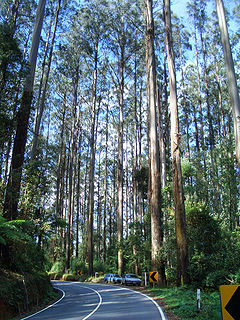
Eucalyptus regnans, known variously as mountain ash, swamp gum, or stringy gum, is a species of medium-sized to very tall forest tree that is native to the Australia states of Tasmania and Victoria. It is a straight-trunked tree with smooth grey bark, but with a stocking of rough brown bark at the base, glossy green, lance-shaped to curved adult leaves, flower buds in groups of between nine and fifteen, white flowers and cup-shaped or conical fruit. It is the tallest of all flowering plants; the tallest measured living specimen, named Centurion, stands 100.5 metres tall in Tasmania.

Eucalyptus pauciflora, commonly known as snow gum, cabbage gum or white sally, is a species of tree or mallee that is native to eastern Australia. It has smooth bark, lance-shaped to elliptical leaves, flower buds in clusters of between seven and fifteen, white flowers and cup-shaped, conical or hemispherical fruit. It is widespread and locally common in woodland in cold sites above 700 m (2,300 ft) altitude.

Eucalyptus diversicolor, commonly known as karri, is a species of flowering plant in the family Myrtaceae and is endemic to the south-west of Western Australia. It is a tall tree with smooth light grey to cream-coloured, often mottled bark, lance-shaped adult leaves and barrel-shaped fruit. Found in higher rainfall areas, karri is commercially important for its timber.
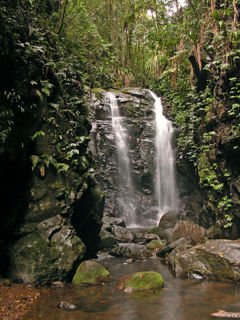
The Gondwana Rainforests of Australia, formerly known as the Central Eastern Rainforest Reserves, are the most extensive area of subtropical rainforest in the world. Collectively, the rainforests are a World Heritage Site with fifty separate reserves totalling 366,500 hectares from Newcastle to Brisbane.

The Shooters, Fishers and Farmers Party (SFF) is an Australian political party. It primarily advocates for increased funding and services for rural and regional Australia, protecting the right to farm, enhancing commercial and recreational fishing, tougher sentencing for illegal firearm trade and usage, and relaxing gun control for law abiding citizens.

Eucalyptus oil is the generic name for distilled oil from the leaf of Eucalyptus, a genus of the plant family Myrtaceae native to Australia and cultivated worldwide. Eucalyptus oil has a history of wide application, as a pharmaceutical, antiseptic, repellent, flavouring, fragrance and industrial uses. The leaves of selected Eucalyptus species are steam distilled to extract eucalyptus oil.
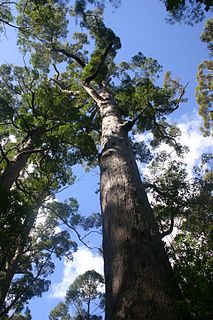
Eucalyptus jacksonii, commonly known as the red tingle, is a species of tall tree endemic to the south west Western Australia and is one of the tallest trees found in the state. It has thick, rough, stringy reddish bark from the base of the trunk to the thinnest branches, egg-shaped to lance-shaped adult leaves, flower buds in groups of seven, white flowers and shortened spherical to barrel-shaped fruit.

Warren, also known as Karri Forest Region and the Jarrah-Karri forest and shrublands ecoregion, is a biogeographic region in southern Western Australia. Located in the southwest corner of Western Australia between Cape Naturaliste and Albany, it is bordered to the north and east by the Jarrah Forest region. Its defining characteristic is an extensive tall forest of Eucalyptus diversicolor (karri). This occurs on dissected, hilly ground, with a moderately wet climate. Karri is a valuable timber and much of the karri forest has been logged over, but less than a third has been cleared for agriculture. Recognised as a region under the Interim Biogeographic Regionalisation for Australia (IBRA), and as a terrestrial ecoregion by the World Wide Fund for Nature, it was first defined by Ludwig Diels in 1906.
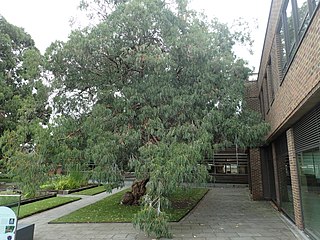
Eucalyptus perriniana, commonly known as spinning gum, is a tree or mallee which is native to New South Wales, the Australian Capital Territory, Victoria and Tasmania. Spinning gum is a sub-alpine species and grows in areas which are normally snow covered for several months in winter. However domestic cultivars can grow in almost any temperate climate.
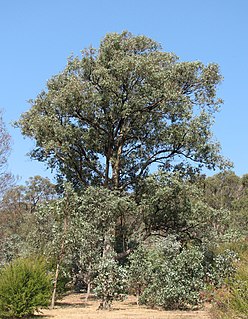
Eucalyptus polyanthemos, commonly known as red box, is a species of small to medium-sized tree, that is native to eastern Australia but has been introduced into other countries. It has fibrous bark on the trunk and larger branches, smooth greyish to cream-coloured bark above, or smooth bark throughout. It has broadly egg-shaped to round juvenile leaves, lance-shaped, egg-shaped or almost round adult leaves, flower buds in groups of seven, white flowers and barrel-shaped to conical fruit.

Eucalyptus oleosa, commonly known as the red mallee, glossy-leaved red mallee, acorn mallee, oil mallee or giant mallee, is a tree or mallee that is native to Australia. The leaves were once harvested for the production of cineole based eucalyptus oil. Eucalyptus cneorifolia is now the predominant strain used in production due to a higher oil content in new growth.
Bertmainius tingle, also called the tingle trapdoor spider, is a small basal spider endemic to the tingle and karri forest of southwestern Western Australia. This migid family species of Bertmainius was first recorded in the 1990s.

Dendrophthoe vitellina, commonly known as long-flowered- or apostle mistletoe, is a hemiparasitic plant of the mistletoe family Loranthaceae. The genus Dendrophthoe comprises about 31 species spread across tropical Africa, Asia, and Australia. Despite being collected by Joseph Banks and Daniel Solander in 1788, and depicted in Banks' Florilegium, it was not until 1860 that it was described by Ferdinand von Mueller as Loranthus vitellinus after being collected near Ipswich, and renamed by Philippe Édouard Léon Van Tieghem in 1895.

The rrrr Separation tree was a heritage listed Eucalyptus camaldulensis tree, commonly known as a red river gum, located in the Royal Botanic Gardens Victoria in Melbourne in Victoria.

The Cazneaux Tree, also known as Cazneaux's Tree, is a Eucalyptus camaldulensis or river red gum that was made famous by the photographer Harold Cazneaux. It is in the Australian state of South Australia in the locality of Flinders Ranges near Wilpena Pound. The tree is located within the boundaries of the Ikara-Flinders Ranges National Park on the west side of the Flinders Ranges Way about 3 kilometres (1.9 mi) north-east of the Wilpena Pound Resort.